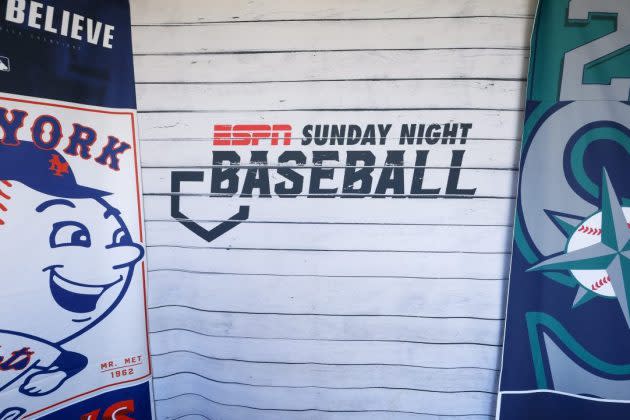
The calculus behind ESPN’s decision to walk away from its longstanding partnership with Major League Baseball may have been a bit knottier than a simple cost-benefit analysis would otherwise suggest—nothing’s ever simple when so many terminal zeroes are involved—but you don’t need an advanced economics degree to intuit that Disney’s departure was inevitable.
For ESPN chairman Jimmy Pitaro, a lifelong baseball fan, the numbers just didn’t add up. MLB wasn’t pulling its weight—at least not to the tune of $550 million per year in rights fees—and ESPN’s move to opt out of the two final seasons of the contract may be interpreted as an act of fiscal discretion rather than an austerity measure.
Perhaps nothing bears this out like the ad sales receipts. According to iSpot data, MLB games in 2024 accounted for 2.2% of the total national linear spend on the ESPN flagship, which translates to $58.5 million over the course of the season. While that’s not a negligible sum, it’s also eminently replaceable. The MLB package last year was ESPN’s 10th-biggest driver of ad sales revenue, trailing the likes of the NHL ($62.8 million), as well as the studio shows Get Up ($79.5 million) and First Take ($96.6 million).
Among the sports holdings in ESPN’s portfolio that may be used to spackle in the Sunday Night Baseball-shaped hole in the lineup are the Stanley Cup Final playoffs in the spring, the College World Series in June and the WNBA in mid-to-late summer.
That advertising in MLB games only clawed back around 10.6% of ESPN’s annual rights fee is less an indictment of baseball’s older demos and the general state of the impressions market than it is a function of basic cable economics. Of the $17.6 billion in revenue generated by the sports unit in 2024, affiliate fees kicked in $10.4 billion, or 59.1% of the total, while advertising accounted for $4.39 billion, or 24.9%. In other words, distribution remains the primary driver of revenue at ESPN—this despite the ongoing erosion of the traditional pay-TV bundle.
Speaking of which, MLB commissioner Rob Manfred’s assessment of ESPN’s place in the hierarchy doesn’t jibe with reality. In the letter Manfred sent to MLB owners on Thursday morning, he states that ESPN “was available in 53.6M homes” as of December 2024. According to Nielsen, the commish undercounted the house by more than 10 million subscribers; as of this month, ESPN and ESPN2 were both in 64.2 million households.
MLB officials were unavailable for immediate comment.
Manfred’s missive also included a curious statement about the overall state of pay-TV, which continues to lose share to streaming platforms. (In the past five years, approximately 42% of subscribers to the legacy bundle have cut the cord, with virtual MVPD packages reducing the impact to a 26% loss.)
“[We] do not believe that pay-TV, ESPN’s primary distribution platform, is the future of video distribution or the best platform for our content,” Manfred wrote, which is remarkable in light of the fact that 80% of MLB’s national TV games are televised by three cable networks (ESPN, FS1, TBS). In taking a jab at ESPN, baseball’s top executive also threw shade on two partners who still have another three years left on their respective contracts.
Manfred told the owners that his team has been “in conversations with several interested parties around these rights over the past several months” and that he expects to have “at least two potential options for consideration over the next few weeks.” But if big-reach broadcast TV would seem to be a dry well—Fox already has its $730 million per year deal in place, CBS isn’t likely to make any major investments while the Paramount sale chugs along, and NBC’s last brush with baseball ended in 2023 when the Peacock deal expired—that either leaves a non-Big Four player like the CW, Ion or a streaming platform.
Amazon Prime Video may be among the best candidates to replace ESPN, although the relative thrift with which MLB has priced its current streaming packages ($90 million for Apple TV’s Friday night exclusives and $10 million for Roku’s Sunday morning games) suggests that it’ll be no easy feat to get one of the tech titans to match the amount of cash that ESPN decided to withhold.
It remains to be seen if Manfred has painted MLB into a corner, but the league’s greatest challenge remains at the RSN level, where approximately 80% of all in-game impressions are served up. Unfortunately, the local media partners are no longer throwing off tens of millions of dollars as they once did, and many smaller-market clubs have been hamstrung as a result. Relief seems long in coming, if it should come at all.
Once hailed as the national pastime, baseball is now very much a local phenomenon, as is evident from last year’s attendance figures (the highest since 2017). In that respect, the loss of a national partnership spanning four decades isn’t exactly the end of the world, but the timing ESPN’s defection does MLB no favors.
More from Sportico.com
Best of Sportico.com
Sign up for Sportico’s Newsletter. For the latest news, follow us on Facebook, Twitter, and Instagram.
EMEA Tribune is not involved in this news article, it is taken from our partners and or from the News Agencies. Copyright and Credit go to the News Agencies, email news@emeatribune.com Follow our WhatsApp verified Channel




